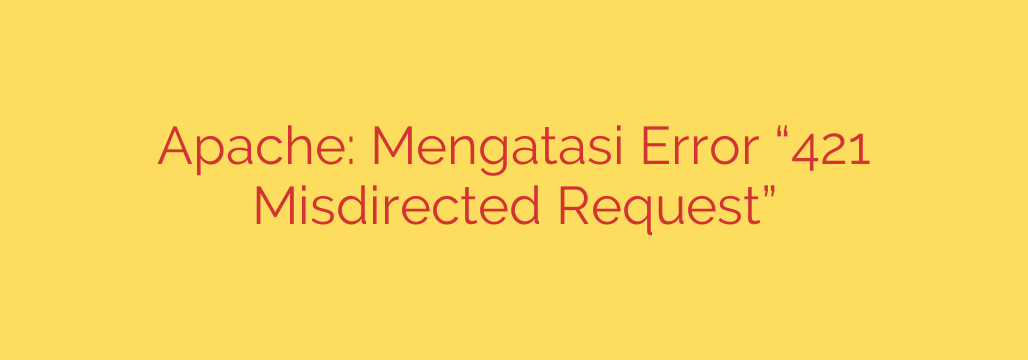
Understanding and Resolving the Apache 421 Misdirected Request Error
Encountering an error on your website can be a frustrating experience, both for you as the site owner and for your visitors. One particularly confusing error is the 421 Misdirected Request. While it’s classified as a client-side error, its root cause almost always lies in a server-side misconfiguration, specifically within your Apache setup.
This guide will walk you through what the 421 error means, its common causes, and a step-by-step process to diagnose and fix it for good.
What Exactly Is a 421 Misdirected Request?
The 421 Misdirected Request error is an HTTP status code indicating that a client’s request was sent to a server that is not configured to produce a response for the requested domain.
Think of it this way: your server has a single IP address (a street address), but it hosts multiple websites (apartments in the building). The client’s request arrives at the correct address, but the name on the request (the hostname, like www.yourdomain.com) doesn’t match any of the “mailboxes” (configured websites) at that location. The server, unable to route the request to the correct website, responds with a 421 error, essentially saying, “You’ve come to the right place, but I can’t handle this specific request.”
This issue is most common in environments using Server Name Indication (SNI), a technology that allows multiple SSL certificates to be hosted on a single IP address.
Common Causes of the 421 Error in Apache
Before you can fix the problem, you need to understand what’s causing it. Here are the most frequent culprits:
- Incorrect Virtual Host Configuration: This is the number one cause. Your Apache configuration file may be missing the specific hostname the user is trying to reach in the
ServerNameorServerAliasdirective of the relevant<VirtualHost>block. - SSL/TLS Certificate Mismatch: The SSL certificate installed on the server does not cover the domain name being requested. For example, a request for
blog.yourdomain.commight fail if the server only presents an SSL certificate valid forwww.yourdomain.com. - DNS Misconfiguration: Your domain’s DNS A record might be pointing to the correct IP address, but the Apache server at that IP hasn’t been told to expect traffic for that domain.
- Improper Load Balancer or Reverse Proxy Setup: If you use a load balancer or a reverse proxy, it might be forwarding traffic for a domain to a backend server that isn’t prepared to handle it.
How to Fix the 421 Misdirected Request Error: A Step-by-Step Guide
Fixing this error involves methodically checking your server’s configuration. Follow these steps to locate and resolve the issue.
Step 1: Verify Your Apache Virtual Host Configuration
The first and most important place to look is your Apache virtual host file. This file tells Apache which domains to listen for and where to find their website files.
- Locate your Apache configuration files. They are typically found in
/etc/apache2/sites-available/(on Debian/Ubuntu) or/etc/httpd/conf.d/(on CentOS/RHEL). - Open the configuration file for the website in question (e.g.,
yourdomain.com.conf). - Inspect the
<VirtualHost *:443>block, which handles HTTPS traffic. - Ensure the
ServerNamedirective matches your primary domain. - Crucially, check the
ServerAliasdirective. It must include all variations of the domain you want to serve, such as thewwwsubdomain.
Here is an example of a correctly configured Virtual Host block:
<VirtualHost *:443>
ServerAdmin [email protected]
ServerName yourdomain.com
ServerAlias www.yourdomain.com
DocumentRoot /var/www/yourdomain.com/public_html
SSLEngine on
SSLCertificateFile /path/to/your/certificate.crt
SSLCertificateKeyFile /path/to/your/private.key
SSLCertificateChainFile /path/to/your/chain.pem
# Other configurations...
</VirtualHost>
If you find a missing ServerName or ServerAlias, add the correct domain, save the file, and proceed to the final step.
Step 2: Check Your SSL Certificate Validity
A mismatched SSL certificate is another common cause. The certificate’s Common Name (CN) or Subject Alternative Name (SAN) must include the exact hostname the user is requesting.
You can use an online SSL checker tool to inspect your certificate. Simply enter your domain name, and the tool will show you which hostnames the certificate is valid for. If the requested domain isn’t listed, you will need to reissue your SSL certificate to include all necessary hostnames.
Step 3: Confirm Your DNS Settings are Correct
While less common if other sites on the server work, it’s always wise to perform a quick DNS check. Use an online DNS lookup tool or a command-line tool like dig to ensure your domain’s A record points to the correct server IP address.
dig yourdomain.com +short
Confirm that the IP address returned by this command is the IP address of your Apache server.
Step 4: Restart Apache to Apply Changes
After making any changes to your configuration files, you must restart the Apache service for those changes to take effect. This is a critical step that is often forgotten.
On Debian/Ubuntu, use the following command:
sudo systemctl restart apache2
On CentOS/RHEL/Fedora, use this command:
sudo systemctl restart httpd
Once Apache has restarted, try accessing your website again. The 421 error should now be resolved.
A Proactive Tip: Perform Regular Configuration Audits
To prevent the 421 error from happening in the future, make it a habit to audit your Apache configuration files regularly. Whenever you add a new website, migrate a domain, or renew an SSL certificate, double-check your Virtual Host files to ensure every ServerName and ServerAlias is correctly defined. This proactive approach can save you from unexpected downtime and maintain a seamless user experience.
Source: https://focusnic.com/blog/apache-solusi-error-421-misdirected-request/








